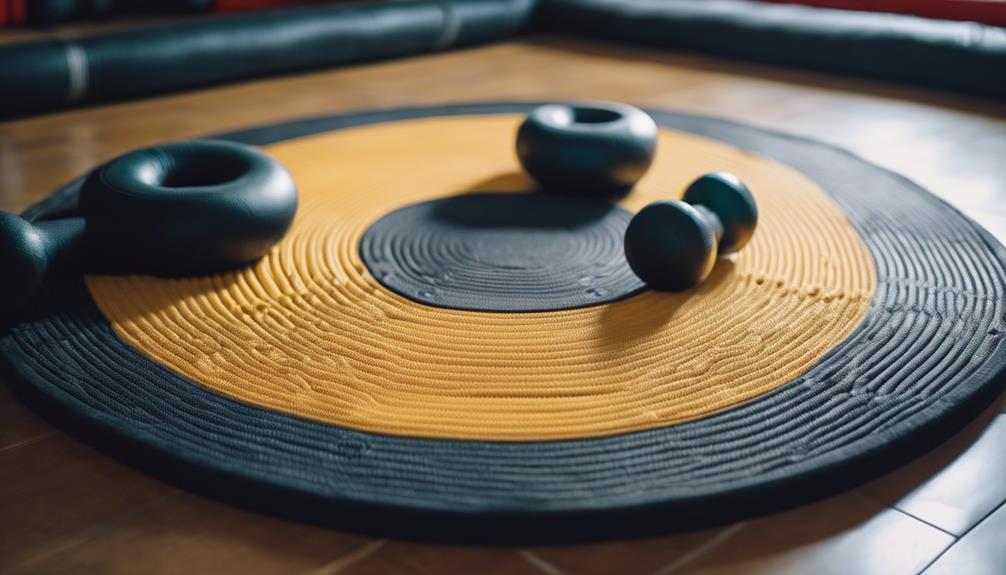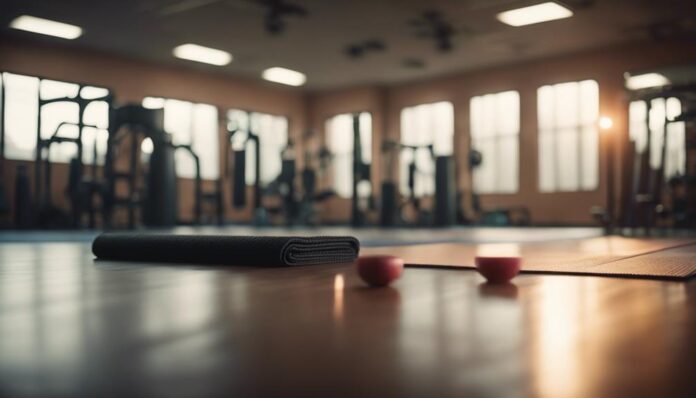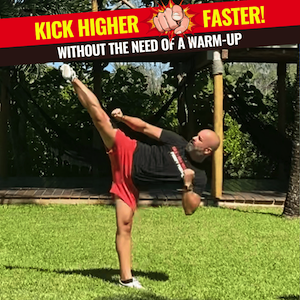To prevent martial arts injuries, you'll want to incorporate a combination of dynamic stretching, strength training, core stability exercises, and balance training into your routine. Dynamic stretching enhances flexibility and blood flow, reducing the risk of strains and sprains. Strength training boosts overall strength and stability, while core stability exercises improve balance and body control. Balance training prevents falls and lower extremity injuries. By incorporating these exercises, you'll greatly reduce your risk of injury and enhance your overall martial arts performance. As you progress, you'll discover additional techniques to further refine your skills and minimize injury risk.
Best Exercises for Injury Prevention
To minimize the risk of injuries in martial arts, incorporating specific exercises into your training regimen is essential. You should focus on dynamic stretching during warm-ups to increase flexibility and blood flow, reducing the risk of strains and sprains.
Include strength training exercises like squats and deadlifts to enhance overall body strength and stability, which is vital for high-impact techniques.
In addition to strength training, incorporate core stability exercises like planks and bridges to improve balance and body control. This will enable you to execute techniques safely and effectively.
You should also engage in balance training, including single-leg stands and stability ball exercises, to prevent falls and lower extremity injuries.
Finally, prioritize cardiovascular conditioning through activities like interval training or swimming to enhance endurance and reduce fatigue-related injuries during prolonged training sessions.
Building Core Strength and Flexibility
Developing a strong core and improving flexibility are essential components of a well-rounded martial arts training regimen. You can enhance your stability and balance by incorporating core strength exercises, such as planks and Russian twists, into your routine. This will reduce the risk of injuries during martial arts practice.
A study has found that individuals with better core strength are less likely to experience lower back injuries, a common issue in martial arts.
To improve your range of motion, engage in flexibility training, including dynamic stretching and yoga. This will enable you to execute techniques safely and effectively. Regular flexibility routines can also decrease muscle stiffness and improve recovery times, allowing for more effective training sessions.
Aim to perform core and flexibility workouts at least three times a week to markedly lower the risk of strains and sprains. By building your core strength and flexibility, you'll be better equipped to handle the physical demands of martial arts training and reduce your risk of injuries.
Make these exercises a priority to take your training to the next level.
Importance of Warm-up and Cool-down
As you prepare for martial arts training, you greatly reduce your risk of muscle strains and other injuries by incorporating a proper warm-up routine, which prepares your joints, muscles, tendons, and ligaments for physical demands.
To maximize the effectiveness of your warm-up, you must also master proper stretching techniques that enhance flexibility and promote ideal performance.
Preventing Muscle Strains
By incorporating a well-structured warm-up and cool-down routine into your martial arts training, you greatly reduce the risk of muscle strains. A sustained warm-up routine of at least 15 minutes, including dynamic stretching, prepares your muscles and joints for the physical demands of martial arts training, considerably reducing the risk of strains.
Incorporating specific warm-up exercises that mimic the movements of martial arts can enhance muscle readiness and improve overall performance during practice.
A proper cool-down routine is just as essential, as it helps your muscles recover from the intense physical activity. Static stretching during cool-down alleviates soreness and prevents tightness that can lead to strains.
Research shows that properly executed warm-ups can decrease the likelihood of muscle strains by up to 50%. By engaging in both warm-up and cool-down practices, you foster better blood circulation and flexibility, fundamental factors in maintaining muscle health and preventing injuries.
Proper Stretching Techniques
Your warm-up and cool-down routines lay the groundwork for preventing muscle strains, but proper stretching techniques are equally important in maintaining flexibility and preventing injuries. To reap the benefits, you need to incorporate a sustained stretching routine into your martial arts training.
Engage in dynamic stretches during your warm-up to increase blood flow and flexibility, preparing your joints, muscles, tendons, and ligaments for the physical demands of training. This will greatly reduce the risk of soft tissue injuries like strains and sprains.
A proper stretching routine should last at least 15 minutes prior to training. Focus on proper technique, moving through stretches smoothly and controlledly.
After your training, cool down with static stretches to aid in muscle recovery, reduce soreness, and improve flexibility. Regular warm-up and cool-down routines contribute to joint stability and overall athletic performance, making injury prevention a key component of martial arts training.
Injury Risk Reduction
Reducing injury risk is paramount in martial arts training, and it begins with a thorough understanding of the importance of warm-up and cool-down protocols. You need to prioritize injury risk reduction to maintain ideal performance and safety during martial arts practice.
Proper warm-up and cool-down protocols can greatly reduce the risk of injuries such as groin strains and hamstring injuries.
- Active warm-ups condition your joints, muscles, tendons, and ligaments, preparing your body for intense movements.
- A sustained stretching routine of at least 15 minutes prior to activity enhances flexibility and prevents muscle strains and sprains.
- Cardiovascular activities help build endurance, reducing fatigue that can lead to poor technique and increased injury risk.
- Cool-down routines that include stretching after training sessions aid in muscle recovery, reducing soreness, and enhancing flexibility, ultimately lowering the risk of overuse injuries.
To effectively reduce injury risk, incorporate active warm-ups, stretching routines, and cardiovascular activities into your martial arts training.
Focus on building muscle strength and endurance, and don't neglect cool-down protocols.
Strength Training for Martial Arts
A martial artist's strength is their greatest asset in preventing injuries and enhancing overall performance. By incorporating strength training into your regimen, you'll improve your physical strength, enabling you to control movements better during techniques. This, in turn, reduces the likelihood of injuries happening.
You can achieve this by adding weights, kettlebells, or bodyweight exercises to your training routine, which will greatly enhance your muscle strength and overall athletic performance.
Regular strength training sessions will also contribute to better joint stability, particularly in the knees and shoulders, areas commonly affected during martial arts practice.
By engaging in a structured strength training program, you'll improve your body mechanics and technique execution, minimizing the risk of injuries caused by improper form.
Studies have shown that athletes who consistently include strength training in their routines experience fewer soft tissue injuries, such as strains and sprains.
Enhancing Technique and Balance

As you focus on enhancing your technique and balance in martial arts, you'll want to prioritize proper stance and footwork, as these fundamentals are essential for generating power and stability during movements.
To achieve this, you'll need to incorporate core strength training methods that target your body's center of gravity, allowing you to maintain balance and control throughout various techniques.
Proper Stance and Footwork
Nearly all martial arts disciplines rely on a solid foundation, with proper stance and footwork playing a critical role in enhancing technique and balance. As you train, you'll want to focus on developing a stable base that allows for quick movement and effective balance during techniques.
A proper stance, such as the horse stance or fighting stance, is essential for maintaining balance and stability.
To improve your footwork and reduce the risk of injuries, consider incorporating the following drills into your training:
- Practice lateral shuffles and forward/backward lunges to enhance agility and balance.
- Maintain a slightly bent knee in your stance to absorb impact and enhance stability.
- Pivot and shift weight between your feet to improve coordination and balance.
- Focus on proper foot placement and weight distribution to decrease the likelihood of ankle sprains and falls.
Core Strength Training Methods
You've developed a solid foundation through proper stance and footwork; now it's time to focus on building core strength to further enhance your technique and balance. As a martial artist, you know that core strength is vital for stability and balance, allowing for better execution of techniques and reducing the risk of falls and injuries during practice.
To target your abdominal muscles, incorporate exercises like planks, Russian twists, and medicine ball throws into your training routine. These exercises improve overall core strength, which is essential for maintaining proper posture and control during high-intensity movements.
Incorporating stability ball exercises into your training can further engage your core muscles, requiring activation of stabilizers to maintain balance, which directly translates to improved performance in martial arts. A strong core also supports the transfer of power from your lower body to your upper body during strikes and grappling maneuvers, enhancing technique effectiveness and minimizing strain on other muscle groups.
Balance Enhancement Techniques
Balance is a critical component of martial arts training, and enhancing it can greatly reduce the risk of injuries during practice. By incorporating balance exercises into your training routine, you can improve your proprioception, agility, and overall technique. This, in turn, enables you to execute movements with precision and control, reducing the likelihood of falls and injuries.
To enhance your balance, consider the following techniques:
- Practice single-leg stands and stability ball workouts to improve proprioception and coordination.
- Incorporate dynamic movements, such as lateral lunges and agility ladder drills, to enhance agility and stability.
- Utilize balance boards or wobble cushions during strength training routines to increase core stability and lower body strength.
- Engage in proprioceptive training, such as yoga or tai chi, to improve overall balance, flexibility, and body awareness.
Regularly incorporating these balance enhancement techniques, along with plyometric exercises like box jumps and hop drills, can considerably improve your balance and reduce your risk of injury during martial arts training.
Cardiovascular Conditioning for Endurance
With a solid foundation of cardiovascular conditioning, martial artists can enhance their endurance, allowing for more intense and prolonged training sessions.
By engaging in regular cardiovascular exercises like running, biking, and swimming, you can greatly boost your energy levels during training and competitions. This, in turn, reduces the risk of fatigue-related injuries, ensuring you're physically prepared for high-intensity workouts.
Aim for at least 150 minutes of moderate aerobic activity each week to optimize heart health and improve overall athletic performance in martial arts.
Incorporating interval training, such as sprinting followed by walking, can effectively boost cardiovascular capacity and mimic the stop-and-go nature of martial arts movements. This type of training prepares your body for the demands of martial arts, helping to prevent injuries and enhance endurance.
By improving your cardiovascular fitness, you'll also aid in faster recovery between training sessions, allowing for more effective practice and reduced injury risk.
Prioritize cardiovascular conditioning to take your martial arts training to the next level.
Functional Training for Martial Arts

Building on the cardiovascular foundation established through regular aerobic activity, functional training becomes an essential component of a well-rounded martial arts regimen.
You'll enhance your overall strength, core stability, and muscle endurance, all of which are crucial for executing martial arts techniques safely and effectively.
To get started, focus on exercises that improve functional movement patterns, such as:
- Kettlebell swings to build explosive power and strength
- Balance exercises like single-leg stands and stability ball movements to develop proprioception and prevent falls
- Plyometric exercises like box jumps and lateral bounds to enhance agility and quick movements
- Mobility drills including dynamic stretching and hip openers to increase range of motion and reduce strain
In Summary
You've mastered the art of kicking and punching, but ironically, your toughest opponent may be your own body. By incorporating exercises that build core strength, flexibility, and balance, you'll be more likely to take down an opponent than be taken down by an injury. Functional training, strength conditioning, and cardiovascular exercises can prevent martial arts injuries. Condition yourself to withstand the fight, and you'll find that your toughest opponent becomes your greatest asset – your own resilience.



